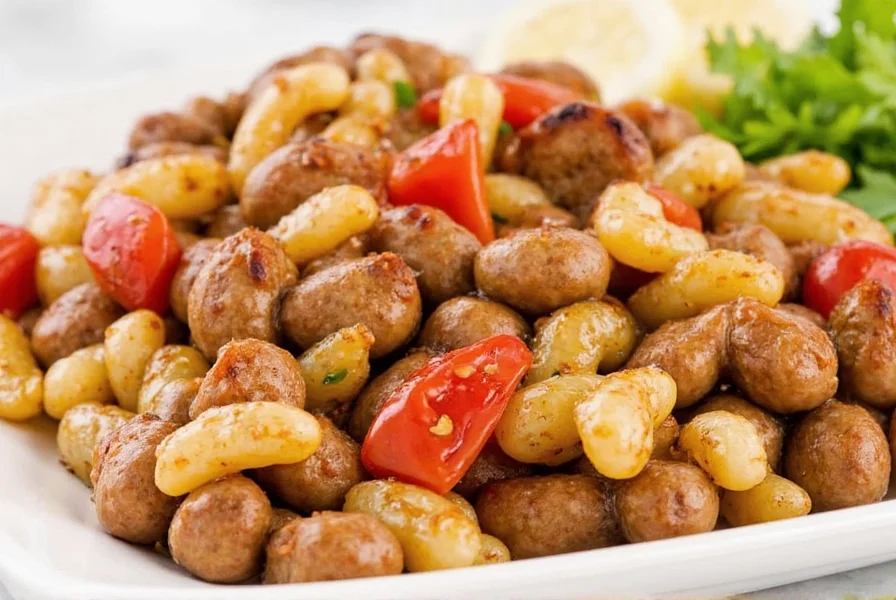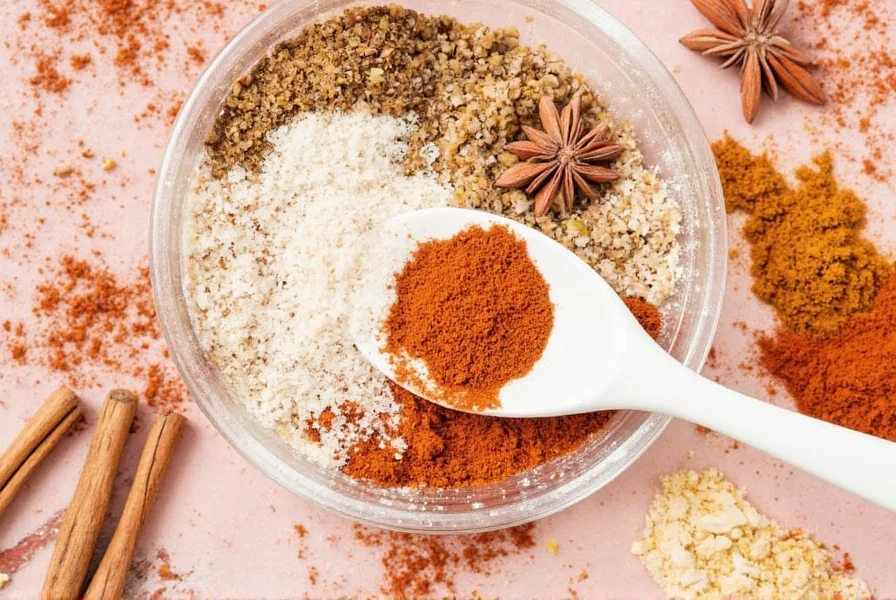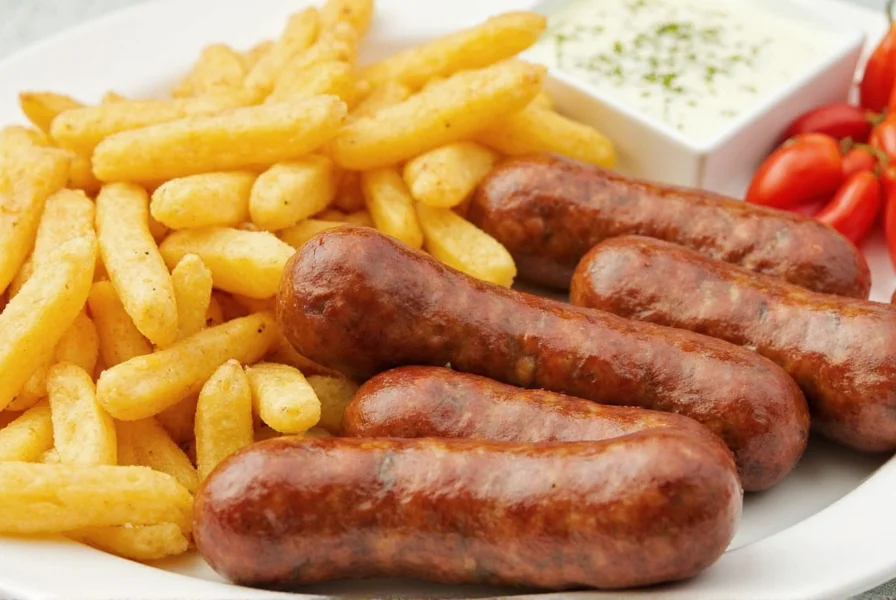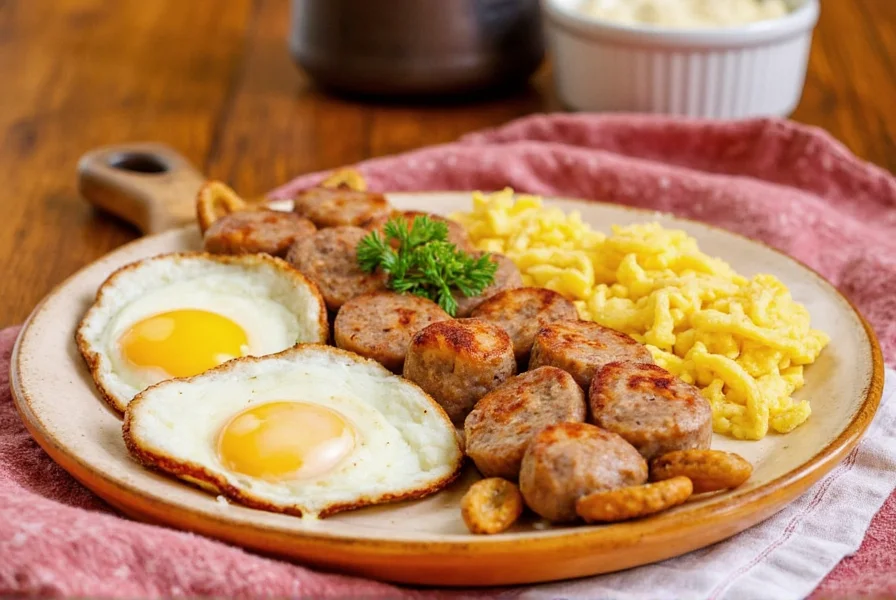For perfectly seasoned breakfast sausage, use this exact spice ratio per pound of ground pork: 1½ teaspoons salt, 1 teaspoon black pepper, 1 teaspoon rubbed sage, ½ teaspoon fennel seed, ¼ teaspoon thyme, and a pinch of nutmeg. This classic American blend delivers the ideal balance of earthy, warm, and slightly sweet flavors that define authentic breakfast sausage.
Why This Specific Seasoning Ratio Works
This precise blend creates the signature flavor profile that makes breakfast sausage irresistible. The salt enhances natural pork flavors while helping bind the meat, black pepper provides essential heat, sage delivers that unmistakable earthiness, fennel adds subtle sweetness, and nutmeg contributes warm complexity. Get these ratios wrong, and you'll end up with either bland or overpowering results.

| Spice | Measurement per Pound | Flavor Contribution |
|---|---|---|
| Salt | 1½ teaspoons | Enhances all flavors, improves texture |
| Black Pepper | 1 teaspoon | Provides essential heat and depth |
| Rubbed Sage | 1 teaspoon | Creates signature earthy breakfast sausage flavor |
| Fennel Seed | ½ teaspoon | Adds subtle sweetness and complexity |
| Thyme | ¼ teaspoon | Contributes herbal notes without overpowering |
| Nutmeg | Pinch | Provides warm background complexity |
Key Ingredients Explained: What Makes Breakfast Sausage Unique
The magic of breakfast sausage lies in its distinctive spice profile. Unlike other sausages, American breakfast sausage relies on sage as its dominant herb, creating that familiar flavor you recognize from diners. Here's why each component matters:
- Freshness matters: Ground your own spices when possible—pre-ground sage loses potency quickly
- Fat content is crucial: Use pork with 20-25% fat content for optimal flavor carrying capacity
- Resting time: Refrigerate seasoned meat for 12-24 hours before cooking for maximum flavor development

| Blend Type | Core Measurements (per lb) | Best For |
|---|---|---|
| Classic American | Salt 1½ tsp, Pepper 1 tsp, Sage 1 tsp, Fennel ½ tsp | Traditional breakfast pairing |
| Smoky Maple | Add 2 tsp maple syrup + ½ tsp smoked paprika | Fall/winter breakfasts |
| Spicy Southwest | Add 1 tsp ancho chili + ½ tsp cumin | Brunch with eggs and avocado |
Step-by-Step: Perfect Breakfast Sausage Every Time
- Select quality meat: Choose freshly ground pork shoulder with visible marbling (20-25% fat)
- Measure precisely: Use measuring spoons, not eyeballing—this is a precision recipe
- Mix thoroughly but gently: Combine spices with meat using clean hands for 2-3 minutes until uniformly colored
- Rest minimum 12 hours: Refrigerate in airtight container—this is non-negotiable for flavor development
- Shape properly: Form ¾" thick patties, slightly wider than your bun (they'll shrink)
- Cook low and slow: 325°F for 12-15 minutes, flipping once when juices appear on surface

Critical Timing Notes
Professional chefs know these timing details make the difference:
- Mixing time: Exactly 2 minutes 30 seconds for 1 pound of meat
- Resting minimum: 12 hours (24 hours produces noticeably better results)
- Cooking temperature: Never exceed 350°F to prevent fat rendering out too quickly
- Internal temperature: Remove from heat at 155°F (carryover cooking will reach 160°F)
Most Common Seasoning Mistakes and Fixes
These errors ruin breakfast sausage more often than you think:
| Common Mistake | Why It Ruins Flavor | Professional Fix |
|---|---|---|
| Using dried sage instead of rubbed sage | Dried sage is too potent and creates bitter notes | Use specifically labeled "rubbed sage" for proper intensity |
| Adding liquid ingredients to raw meat | Creates texture problems and prevents proper browning | Mix liquids with dry spices first, then incorporate |
| Not resting the seasoned meat | Spices don't penetrate, resulting in uneven flavor | Minimum 12-hour refrigeration before cooking |
| Overmixing during preparation | Creates dense, tough texture instead of crumbly perfection | Stop mixing when color is uniform (about 2-3 minutes) |

7 Restaurant-Worthy Flavor Variations
Once you've mastered the classic blend, try these chef-developed variations:
- Maple-Bacon Breakfast Sausage: Add 2 tsp real maple syrup + ¼ cup finely chopped cooked bacon (reduce salt by ¼ tsp)
- Apple-Sage Autumn Blend: Mix in 3 tbsp finely diced dried apples + ½ tsp cinnamon (add after resting)
- Southwest Chipotle: Incorporate 1 tsp chipotle powder + ½ tsp cumin + lime zest from 1 lime
- Mediterranean Herb: Substitute thyme with oregano + add 1 tsp lemon zest + 2 minced garlic cloves
- Spicy Maple: Combine 2 tsp maple syrup + ½ tsp cayenne pepper + 1 tsp smoked paprika
- Black Pepper & Brandy: Add 1 tbsp brandy + increase black pepper to 1½ tsp (add after resting)
- Garlic & Herb Garden: Mix in 3 minced garlic cloves + 1 tbsp fresh chopped rosemary + 1 tbsp fresh thyme
Frequently Asked Questions About Seasoning Breakfast Sausage
What's the exact spice ratio for perfect breakfast sausage?
For one pound of ground pork, use precisely: 1½ teaspoons salt, 1 teaspoon black pepper, 1 teaspoon rubbed sage, ½ teaspoon fennel seed, ¼ teaspoon thyme, and a pinch of nutmeg. This ratio delivers balanced flavor without any single spice dominating.
Why does my homemade sausage taste different from restaurant versions?
Most commercial breakfast sausages use this exact spice ratio but with two critical differences: they rest the meat for 24-48 hours (not just 12), and they use freshly ground spices. The resting time allows salt to penetrate deeply and enzymes to develop more complex flavors.
Can I make this without a meat thermometer?
While a thermometer is ideal, you can check doneness by pressing the sausage patty: it should feel firm but slightly springy. Another method: cut into one patty to check for uniform color with no pink remaining. For best results, invest in an instant-read thermometer and remove at 155°F (carryover cooking will reach safe 160°F).
How do I fix over-seasoned sausage?
If you've added too much spice, incorporate additional unseasoned ground pork at a 1:1 ratio. For salt issues specifically, add 1-2 tablespoons of unsweetened applesauce per pound of meat to balance the saltiness without diluting flavor.
What's the difference between rubbed sage and regular dried sage?
Rubbed sage is specifically processed to be lighter and more crumbly, with about half the potency of regular dried sage. Using regular dried sage will make your sausage bitter. Always use "rubbed sage" for authentic breakfast sausage flavor.
Essential Tools for Perfectly Seasoned Sausage
These professional tools make a significant difference in consistency and flavor development:
| Tool | Critical Function | Professional Recommendation |
|---|---|---|
| Digital Scale | Precise spice measurement (volume measurements vary) | Use grams for spices: 8g salt, 5g pepper, 5g sage per pound |
| Stainless Steel Mixing Bowl | Chill bowl before mixing for better fat retention | Place bowl in freezer 15 minutes before mixing |
| Instant-Read Thermometer | Prevents overcooking which dries out sausage | Remove at 155°F (carryover to 160°F) |
| Spice Grinder | Freshly ground spices dramatically improve flavor | Grind fennel seeds immediately before use |
Mastering Breakfast Sausage Seasoning: The Final Key
The secret to perfect breakfast sausage isn't just the spice ratio—it's understanding how time transforms the flavor. Professional kitchens always rest seasoned sausage for 24-48 hours before cooking, allowing the salt to penetrate deeply and enzymes to develop more complex flavors. For best results, prepare your sausage the night before, refrigerate, and cook fresh in the morning. This simple step makes the difference between good homemade sausage and extraordinary, restaurant-quality results that will have everyone asking for your secret.

Remember: precise measurements, proper resting time, and cooking temperature control are the triumvirate of perfect breakfast sausage. Implement these techniques, and you'll never settle for store-bought again.











 浙公网安备
33010002000092号
浙公网安备
33010002000092号 浙B2-20120091-4
浙B2-20120091-4